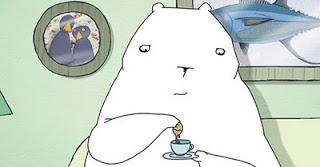 Big Wednesday
Big Wednesday Jane Eyre
Jane Eyre The Cabinet of Dr. Calagari
The Cabinet of Dr. Calagari
Animator, writer, ASIFA-East executive board member, and teacher Rich Gorey and I have been close friends for over ten years. When we meet up for lunch, Rich never fails to ask me what animated films I’ve recently seen that knocked my socks off. Much to his dismay, I don’t always wear socks, nor do I usually have a ready answer for this question. As I’ve recently posted, these days I’m getting my kicks from a whole host of film. In the last two weeks I’ve watched the breathtaking German silent film The Cabinet of Dr. Calagari (1920), the under-appreciated surfer epic Big Wednesday (1978), Sidney Lumet’s lush Murder on the Orient Express (1974), with a performance by Albert Finney that was simply sublime, and the gothic wonder of Robert Stevenson’s Jane Eyre (1943). In light of such stimulating viewing, I can’t say that I always have animation as my go-to source for creative inspiration.
But with teaching season starting up again I’m reminded of a whole host of animated gems that I keep returning to in hopes to inspire my students. Of course, the result of which is always that I’m inspired anew. I remember Howard Beckerman telling me that he’s played Yellow Submarine so many times that he’ll often train his eyes on one corner of the screen, which can reveal new delights in a film you already know inside-out.
I haven’t been teaching any where nearly as long as Howard, so I can’t say I’m up to corner-viewing yet, but I have very much enjoyed revisiting certain films again and again through in-class screenings. A cornerstone of my film selection is anything by Paul Fierlinger. The artistry, storytelling, and honesty in such Fierlinger films such as Still Life With Animated Dogs and A Room Nearby (pictured below) cannot be topped. There’s something so personal about his work. It’s as if the animation is unspooling in real time, keeping pace with his feelings and thoughts.

Another short that I always play is the more recent John and Karen by Matthew Walker. I can’t think of a short animated film in recent memory that has charmed me more. The animation acting is as subtle as it is hilarious. The little Penguin can cut down the giant Polar Bear with a squint of her eye, and the Polar Bear (in turn) can barely make eye contact with her.

As animation professors we die a little inside every time a student wants to animate a space battle or a dragon fight instead of trying to tackle an intimate character study such as John and Karen. Some of us take a while to realize that everyday life is full of meaty stories and moments that could inspire powerful animations. I’m 36 years old and hopefully I’ve finally learned that lesson myself.
Finally, there’s John R. Dilworth’s 2002 short The Mousochist, which I think is among his greatest works. The whole animation takes place in one scene, with only one camera move save for the climatic end. Yet, you’re never bored with the simplicity (which even extends to the nearly stark-white backdrop), because the character animation is so engaging. Dilworth is such a talent that he can draw a difficult angle of a character screwing on its nose in back view, and make the action read as clear as if it was staged in a more obvious position facing camera. Along with Dilworth’s economy of art is his “needle-drop” approach to music, which perfectly suits the changing moods of his character.  Time spent with such masterful animated shorts helps spotlight what amazing work can be done with so little, proving that effective animation is about a lot more than just fancy drawings. So, Rich Gorey, I suppose I can answer your question after all.
Time spent with such masterful animated shorts helps spotlight what amazing work can be done with so little, proving that effective animation is about a lot more than just fancy drawings. So, Rich Gorey, I suppose I can answer your question after all.


